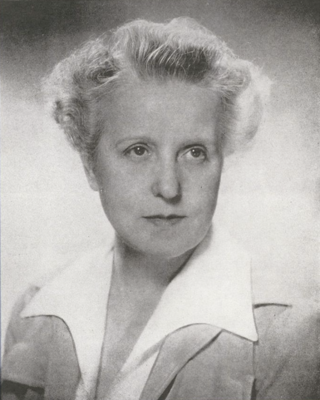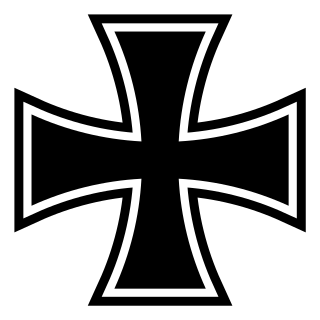
Otto Johann Anton Skorzeny was an Austrian-born German SS-Obersturmbannführer in the Waffen-SS during World War II. During the war, he was involved in a number of operations, including the removal from power of Hungarian Regent Miklós Horthy and the Gran Sasso raid which rescued Benito Mussolini from captivity. Skorzeny led Operation Greif in which German soldiers infiltrated Allied lines wearing their enemies' uniforms. As a result, he was charged in 1947 at the Dachau Military Tribunal with breaching the 1907 Hague Convention, but was acquitted.

Hans Josef Maria Globke was a German administrative lawyer, who worked in the Prussian and Reich Ministry of the Interior in the Reich, during the Weimar Republic and the time of National Socialism. Later he was the Under-Secretary of State and Chief of Staff of the German Chancellery in West Germany from 28 October 1953 to 15 October 1963 under Chancellor Konrad Adenauer. He is the most prominent example of the continuity of the administrative elites between Nazi Germany and the early West Germany.
ODESSA is an American codename coined in 1946 to cover Nazi underground escape-plans made at the end of World War II by a group of SS officers with the aim of facilitating secret escape routes, and any directly ensuing arrangements. The concept of the existence of an actual ODESSA organisation has circulated widely in fictional spy novels and movies, including Frederick Forsyth's best-selling 1972 thriller The Odessa File. The escape-routes have become known as "ratlines". Known goals of elements within the SS included allowing SS members to escape to Argentina or to the Middle East under false passports.

Hans-Ulrich Rudel was a German ground-attack pilot during World War II and a post-war neo-Nazi activist.
The Fourth Reich is a hypothetical Nazi Reich that is the successor to Adolf Hitler's Third Reich (1933–1945). The term has been used to refer to the possible resurgence of Nazi ideas, as well as pejoratively by political opponents.

The ratlines were systems of escape routes for German Nazis and other fascists fleeing Europe from 1945 onwards in the aftermath of World War II. These escape routes mainly led toward havens in the Americas, particularly in Argentina, though also in Paraguay, Colombia, Brazil, Uruguay, Mexico, Peru, Guatemala, Ecuador, and Bolivia, as well as the United States, Canada, Australia, Spain, and Switzerland.
A Nazi hunter is an individual who tracks down and gathers information on alleged former Nazis, or SS members, and Nazi collaborators who were involved in the Holocaust, typically for use at trial on charges of war crimes and crimes against humanity. Prominent Nazi hunters include Simon Wiesenthal, Tuviah Friedman, Serge Klarsfeld, Beate Klarsfeld, Ian Sayer, Yaron Svoray, Elliot Welles, and Efraim Zuroff.

Sigrid Schultz was a notable American reporter and war correspondent in an era when women were a rarity in both print and radio journalism. Working for the Chicago Tribune in the 1920s, she was the first female foreign bureau chief of a major U.S. newspaper.

Uki Goñi is an Argentine author. His research focuses on the role of the Vatican, Swiss authorities and the government of Argentina in organizing "ratlines"—escape routes for Nazi criminals and collaborators.

Kessler is a television series produced by the BBC in 1981, starring Clifford Rose in the title role. The six-part serial is a sequel to the Second World War drama series Secret Army, set in contemporary times.

Antonio Caggiano was an archbishop and a cardinal of the Roman Catholic Church in Argentina. He played a part in helping Nazi sympathisers and war criminals escape prosecution in Europe by easing their passage to South America.

The Paladin Group was a far-right organization founded in 1970 in Spain by former Waffen-SS Colonel Otto Skorzeny. It conceived itself as the military arm of the anti-Communist struggle during and after the Cold War. It was a private security contractor, the group's purpose was to recruit and operate security contractors to protect anticommunist countries. The group had active communications with post-war SS veteran networks and can be argued to be one of those networks, differing in the fact that they were also providing troops and training to far-right militias, and was a participant of Operation Condor, providing escape routes for former SS-men who were guilty of war-crimes.

Pierre Daye was a Belgian journalist and Nazi collaborator. As supporter of the Rexist Party, Daye exiled himself to Juan Peron's Argentina after World War II.

Foreign relations between Argentina and Germany have existed over a century. The free city-state of Hamburg was the first German state to establish diplomatic relations with Argentina in 1829. The first ambassador of Germany to Argentina was sent on 7 May 1871.

Germany–Paraguay relations are the diplomatic relations between Germany and Paraguay. Both nations enjoy friendly relations, the importance of which centers on the history of German migration to Paraguay. Approximately 300,000 Paraguayans claim German origin. Both nations are members of the United Nations.

The Eichmann trial was the 1961 trial in Israel of major Holocaust perpetrator Adolf Eichmann who was kidnapped in Argentina by Israeli agents and brought to Israel to stand trial. Eichmann was a senior Nazi party member and served at the rank of Obersturmbenführer (Lieutenant-Colonel) in the SS, and was one of the people primarily responsible for the implementation of the Final Solution. He was responsible for the Nazis' train shipments from across Europe to the concentration camps, even managing the shipment to Hungary directly, where 564,000 Jews died. After World War II he fled to Argentina, living under the pseudonym "Ricardo Clement" until his capture in 1960 by Mossad.

Friedrich Tete Harens Tetens was a German journalist and writer. He was born in Berlin in 1899 and imprisoned in Oranienburg concentration camp (1933) before emigrating to Switzerland (1934), Argentina (1936) and finally the United States (1939). He died in 1976.
René Lagrou was a Belgian politician and collaborator with Nazi Germany.
Juan Carlos Goyeneche was an Argentine Catholic nationalist politician. Also highly sympathetic to Nazism, during the Second World War Goyeneche travelled to Nazi Germany where he met a number of leading figures. He was the son of Mayor of Buenos Aires Arturo Goyeneche and the grandson of a President of Uruguay.

Horcher is a restaurant in Madrid, Spain. It moved to Madrid in 1943 having originally opened in Berlin, Germany, in 1904. It was a popular restaurant with the elite of Nazi Germany.















